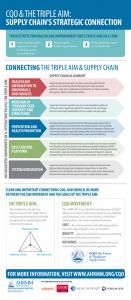CQO & The Triple Aim: Supply Chain's Strategic Connection
The Institute for Healthcare Improvement (IHI) Triple Aim is a framework developed to describe an approach to optimizing health system performance.
The Triple Aim calls for:
- Improving the patient experience of care (including quality and satisfaction)
- Improving the health of populations; and
- Reducing the per capita cost of healthcare.
Clear and important connections can, and should, be made between the Cost, Quality, and Outcomes (CQO) Movement and the goals of the Triple Aim. The AHRMM Board of Directors has crafted a concise, informative graphic to demonstrate where and how the healthcare supply chain positively impacts the goals of the Triple Aim. Healthcare supply chain professionals should review and familiarize themselves with this information in order to demonstrate supply chain’s essential role in pursuing the Triple Aim.
Also, be sure to check out AHRMM resources aligned with components of the Triple Aim.
Click on the link below to download the infographic:
AHRMM offers numerous resources to assist healthcare supply chain professionals implement aspects of the CQO Movement and the Triple Aim.
Access these educational offerings to get started on aligning of the Triple Aim components in your facility:
HEALTHCARE INFORMATION TO INDIVIDUALS AND FAMILIES:
- On-Demand Recording: Delivering High Quality Healthcare for Low Cost: Rethinking Supplies in the OR
- CQO Leading Practice: Reduction or Elimination in Hospital Acquired NPU - Terrebonne General Medical Center
REDESIGN OF “PRIMARY CARE SERVICES” AND STRUCTURES:
- 2015 AHRMM CQO Report: Uncovering Applications of the CQO Movement throughout Healthcare.
- AHRMM Fellow Paper: A Framework for Success: Applying the Baldrige Excellence Framework to the Healthcare Supply Chain
PREVENTION AND HEALTH PROMOTION:
- CQO Leading Practice Repository
- On-Demand Recordings:
COST CONTROL PLATFORM:
- AHRMM13 White Paper & Brief: Cost, Quality, and Outcomes: The Supply Chain Value Equation.
- SCS&S Magazine Article:
- Value Based Purchasing Awareness Brief
SYSTEM INTEGRATION:

